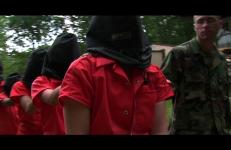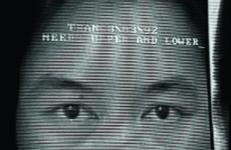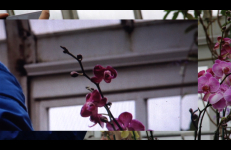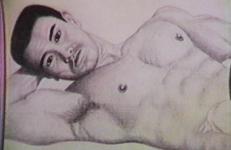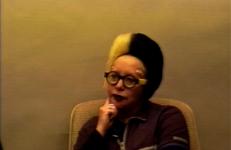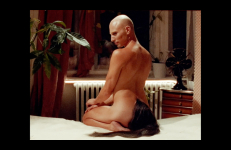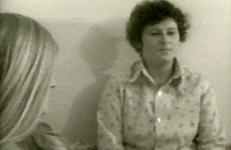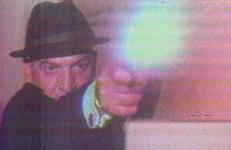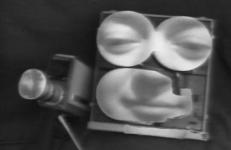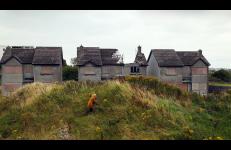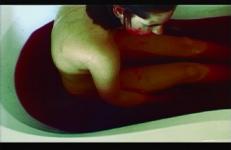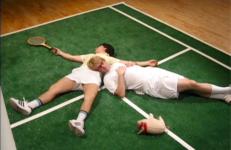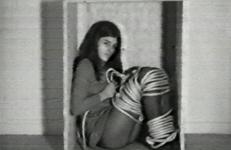In this episode of The Brenda and Glennda Show, Glennda meets up with guest co-host Joan Jett Blakk to discuss Blakk’s 1992 presidential run. The pair interview people on the street outside of the 1992 Democratic Convention. They discuss topics including the police state, weaknesses of the two-party political system, feminism, and political elitism.
Gender
In One Man Ladies, Glennda Orgasm is joined by Vaginal Davis as they meet women on the streets of New York City to discuss Laura Schlessinger's book Ten Stupid Things Women Do to Mess Up Their Lives. The pair humorously explore the best ways modern women can find and secure a husband.
An episode of Glennda and Friends, hosted by Glennda Orgasm and Vaginal Davis.
Operation Atropos is a documentary about interrogation and POW resistance training. Director Coco Fusco worked with retired U.S. Army interrogators who subjected her group of women students to immersive simulations of POW experiences in order to show them what hostile interrogations can be like and how members of the U.S. military are taught to resist them. The group of interrogators is called Team Delta, and they regularly offer intensive courses that they call "Authentic Military Experiences" to civilians.
Are gender outlaws considered the new biological terrorists seeking weapons of mass bodily destruction? OPERATION INVERT compares the different regulations mediating botox-related plastic surgery and gender reassignment "sex change." Historical medical assessments of the invert (homosexual and transsexual) "condition" reveal seemingly outdated absurdities about outsider deviance. Nonetheless, current institutional loopholes governing gender re-assignment surgery suggest a fresh resurgence of loony pathology and diagnosis.
The artist visits with seven cosmetic surgeons specializing in blepharoplasty (cosmetic eyelid creasing surgery) in the West Hollywood/Beverly Hills area for initial consultation sessions. The doctors demonstrate different reshaping options and comment upon the prevalence and success rates for different Asian nationalities while Tran presents statistics and facts in text that frame the consultations.
This title is also available on Tran, T. Kim-Trang: The Blindness Series.
A video work that documents the annual orchid show at the New York Botanic Garden, Orchid Show critically observes notions of spectacle, gender and beauty as a query into the staging and imaging of nature. For the audio, the sounds of the garden fold into a classical composition for piano, Kaleidoscopic Changes on an Original Theme, Ending with a Fugue (1924) by Ruth Crawford Seeger, one of the few celebrated female composers of the early 20th century.
In response to the dominant impression that gay people are white people, Orientations aims to set the record straight on homosexual identity. More than a dozen men and women of different Asian backgrounds speak frankly, humorously, and often poignantly about their lives as members of a minority within a minority. They speak about coming out, homophobia, racism, cultural identity, sex, and the ways that being gay and Asian have shaped who they are.
French performance artist Orlan uses her own body as a sculptural medium. Since 1990, she has worked on La Reincarnation de Sainte-Orlan, a process of plastic surgeries that she “performs,” making elaborate spectacles with surgeons dressed in sci-fi costumes and broadcasting the operations live via satellite to galleries worldwide. By exploring a total transformation of self, Orlan delves into issues of identity and the malleability of the flesh. She lives and works in Paris, exhibiting and performing internationally.
Interview by Shay Degrandis, via translator.
A "young woman who finds herself surrounded by the relics of Western culture" is the subject of Richard Foreman's formal tableaux. The narration centers on a young woman's struggle to find a relation between her body and her self as mediated by language. The text is a poetry of formal relations that carries personal and historical implications, including the desires of the woman paradoxically voiced by a male narrator. The title suggests the vivid virtuality of dreaming; scenes repeatedly refer to both reading and sleeping.
A foley artist creates sounds for a film featuring a dressage horse and dissolves into their own imitation. As the character in the film, played by the gender fluid performer Simon(e) Jaikiriuma Paetau seems to transform into a gender-defying centaur, the film reflects on the boundaries between the human and the animal as well as on fictional gender roles and their transcendence. Shot on 16mm film, Passage alludes to Eadweard Muybridge’s pre-cinematic experiments with horses.
Written, Directed, Produced & Edited: Ann Oren
Perils is a homage to silent film—the clash of ambiguous innocence and unsophisticated villainy—dramatizing the theatrical postures of melodrama to confront and examine our ideas of romance, action, and drama. Child says, “I had long conceived of a film composed only of reaction shots in which all causality was erased. What would be left would be the resonant voluptuous suggestions of history and the human face.” Charles Noyes and Christian Marclay constructed the sound montage from Warner Brothers cartoons and improvisations.
The setting for The Politics of Intimacy recalls the widespread consciousness-raising (CR) groups in the late '60s and early '70s inspired by the emerging feminist movement. CR groups provided a forum to openly and collectively validate women's otherwise private experiences. In the tape Dr. Sherfy, one of the first doctors to write about female sexuality, and nine women of different ages, sexual preferences, and economic and social situations discuss their sexual experiences.
Pop-Pop Video: Kojak/Wang takes a shootout from Kojak and extends the shot and counter-shot into a potentially endless battle. In the original TV fragment, images, gestures and actions rebound off one another like the echoes of repeated bursts of gunfire. Birnbaum compares gunfire with the beams of laser light from a computer in a Wang commercial, connecting destruction and violence with the products of advancing technology.
This eight-minute video is part experimental video art, part sketch comedy routine, and part informational lesson on the advantages and disadvantages of owning Sony's latest video technology. In it, David and Carol participate in a brilliantly theatrical, seemingly improvisational conversation, in which each one adopts the specific identity and perspective associated with a particular video technology: David plays the part of the Sony Camera AVC 3400, while Carol takes on the personality of the Sony Portapak AV3400.
In Post Queer Pride 93, Brenda and Glennda attend the New York City Queer Pride Parade. This video marks the return of Brenda after her relocation to Florida, and Glennda interviews her about the queer scene and gay activism in the South. At the parade, they conduct interviews with queers about the postqueer movement, the leather and SM scene, feminism, and capitalism.
Five prayers are sent skyward, and five curses get directed inward by those living in the purgatory of "modern life"... Attend this moody Mass in the church of "thoughts and feelings"... It will uplift you.
This title comprises Wrestling with Angels (2015), Hiding Places (2016), Unfinished Paradise (2018), Late Night Blues (2016) and Nightscape (2017) which were compiled into this form by Mike Kuchar in 2022.
Prefaces is composed of wild sounds constructed along entropic lines, placed tensely beside bebop rhythms, and a resurfacing narrative cut from a dialogue with poet Hannah Weiner. Child tells us, “The tracks are placed in precise and asynchronous relation to images of workers, the gestures of the marketplace, colonial Africa, and abstractions, to pose questions of social force, gender relations and subordination.” This tape serves as a pre-conscious preface to the parts that follow, whose scope and image bank are more narrowly defined.
Pulling Up Roots is the emotional journey of a woman who is navigating the tenuous strain between the past and the future.
Filmed in an abandoned housing project in Western Ireland, she uproots exotic plants and flowers, as one might collect stories and memories one can’t understand. Condit’s operatic songs and childlike rhymes give a sense of naiveté and strength that comes from her solitude. From a playful skip around the yard, to a moment where profound sadness gives way to unexpected laughter, she explores an entire lifetime of emotions in mere minutes.
Putting the Balls Away is a reenactment of the historic September 21, 1973, tennis match between Billie Jean King and Bobby Riggs, created for broadcast on the 35th anniversary of the original event. The Battle of the Sexes was the most-watched live sporting event at that time, and pitted chauvinist against feminist, when women tennis players demanded equal pay to that of their male counterparts. Both players are performed by Mateik, whose work wages strategic operations to overthrow institutions of compulsory gender. After each game the competitors "switch sides".
In Queens on the Media Scene, East Village drag queen Linda Simpson (of My Comrade zine) joins Glennda to discuss the explosion of drag in the mainstream media, and the pair interview passers-by on the streets of Midtown Manhattan. They discuss the rising acceptance of drag in the mainstream, in part due to the media presence of RuPaul; the potential taming of drag or its normalization; and an ambition to preserve the more taboo aspects of drag expression in the face of increasing popularization.
Budlong Memorial Middle School is heating up. Queer Teen Romance is a charmingly perverse homage to the after-school special that tackles bullying in a hormone-fueled flurry of forbidden sexual fantasy. When Bryce, the school bully, picks on outcast Kevin, a group of tough (and brightly accessorized) girls decide to teach Bryce a lesson. But maybe Kevin doesn’t want the pain to stop?
Two performers, Acconci and a young woman, occupy two wooden boxes in separate rooms, connected via monitor, camera, and microphone. The situation is symbolic of a vicarious and distended power relation, a relationship built through and reliant upon technological mediation. Watching her on a monitor, Acconci coaches the woman through tying herself up, urging her to pretend he is winding the rope around her legs and neck.
Representing the complex lives of transgender and gender variant musicians in the US and Canada, Riot Acts offers a first-hand perspective of the intersections between gender performance and stage performance. The featured performers are talented, inspiring, sexy, critical and three-dimensional in a manner that purposefully counters mainstream media. Discussions range from songwriting, performance, voice presentation and voice changes, passing/not passing, audience, to the idea of the spectacle, drag, and media representation - the personal is always political.
In this episode of The Brenda and Glennda Show, Brenda and Glennda lead a group of drag queens on a trip to Donald Trump’s Taj Mahal Hotel & Casino in Atlantic City. Intended to be a drag queen gambling getaway and a public stage for drag visibilty, the trip turns into a moment of protest and reflection incited by homophobic discrimination. The group is kicked out of the gambling area for supposedly wearing excessive makeup and inapprorpiate, flashy attire — somehow unlike and worse than that of the casino's showgirls and other heavily powdered female patrons.






